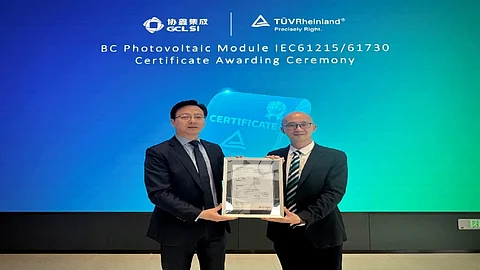

Solar cell and module manufacturer GCL SI's back contact (BC) high-efficiency single-glass and dual-glass modules have received IEC 61215 and IEC 61730 certifications from TÜV Rheinland. In December last year, the company launched its GPC2.0 high-efficiency module based on BC technology, achieving a maximum power output of 660 W in dimensions of 2382 x 1134 mm. GCL SI claims the GPC2.0 module delivers a 30 W power increase over conventional technologies, with a 4.8% capacity gain per installation area. The company says these features make it deliver greater spatial value for commercial rooftops. Under equivalent LCOE across the product lifecycle, the module is said to demonstrate a 10% system cost advantage. Among its other features, GCL SI says the module’s linear ribbon design reduces microcrack risks by 20%, while anti-shading technology lowers operating temperatures by 20°C, aiding reliability in harsh environments.
Last month, GCL SI won a bid in CR Power’s auction to supply 900 MW of modules with a power output ≥ 620 W (see China Solar PV News Snippets).
Solar PV leader LONGi has released data from an 8-month unshaded rooftop PV project in Xi'an City, Shaanxi Province. It compares the company’s Hi-MO 9 BC modules (2nd-gen BC tech) against TOPCon modules under identical conditions. From March to October 2024, Hi-MO 9 modules showed a 1.01% power generation advantage per kW, peaking at 1.73% daily. Cumulative generation reached 1,260.59 kWh for BC modules versus 1,170.03 kWh for TOPCon – a 7.74% performance gap favoring BC technology.
Recently, LONGi announced that it had completed the HPBC 2.0 transition of its Jiaxing City, Zhejiang Province manufacturing base (see China Solar PV News Snippets).
Leading energy developer China Datang has announced the winning candidates for its 2025-2026 solar module framework procurement, for a total of 22.5 GW capacity divided into 3 bidding sections.
Section 1 involves the procurement of 19.5 GW of n-type TOPCon modules. 10 companies, including JinkoSolar, JA Solar, Tongwei Solar, and LONGi, were shortlisted, with bid prices ranging from RMB 0.692 ($0.0956) to RMB 0.705/W ($0.0974).
Section 2, for 2 GW of n-type heterojunction (HJT) modules, saw 3 candidates shortlisted. They are: Huasun, with a bid of RMB 0.7075/W ($0.0978); Risen Energy with a bid of RMB 0.723/W ($0.0999); and SPIC with a bid of RMB 0.722/W ($0.0997).
Section 3, for 1 GW of n-type BC modules, saw 2 shortlisted candidates: AIKO with a bid of RMB 0.745/W ($0.1029), and LONGi with a bid of RMB 0.75/W ($0.1036).
Microinverter manufacturer APsystems announced that its revenue grew by 26.36% year-over-year (YoY) in 2024, reaching RMB 1.79 billion ($247.85 million). However, its net profit declined, with net income attributable to the parent company reaching RMB 142.30 million ($19.65 million), a decrease of 35.38% YoY.
According to the company, the revenue growth was primarily driven by successful expansion into the commercial and industrial (C&I) energy storage market. The decline in net profit was attributed mainly to fluctuations in foreign exchange rates, which led to increased financial expenses.
The topic of ‘renewable energy’ figured multiple times in Chinese Premier Qiang Li’s speech on government work report at the 3rd session of the 14th National People's Congress. In 2024, China focused on driving energy-saving and carbon-reduction upgrades in key industries, advancing the development and utilization of new energy, with non-fossil fuel power generation expected to account for nearly 40% of total electricity generation.
According to the report, China aims to coordinate carbon reduction, pollution control, ecological conservation, and economic growth while accelerating a comprehensive green transformation of the economy and society in 2025. Specific initiatives include the implementation of green and low-carbon advanced technology demonstration projects, encouraging new growth drivers such as green buildings, launching the 2nd batch of national carbon peaking pilot programs, and establishing zero-carbon parks and factories. Additionally, China aims to expedite the development of renewable energy bases in deserts, Gobi, and barren/waste lands, advance offshore wind power, and optimize local consumption and power transmission pathways. The report also said that the government will initiate pilot projects for low-carbon retrofits of coal-fired power plants.
